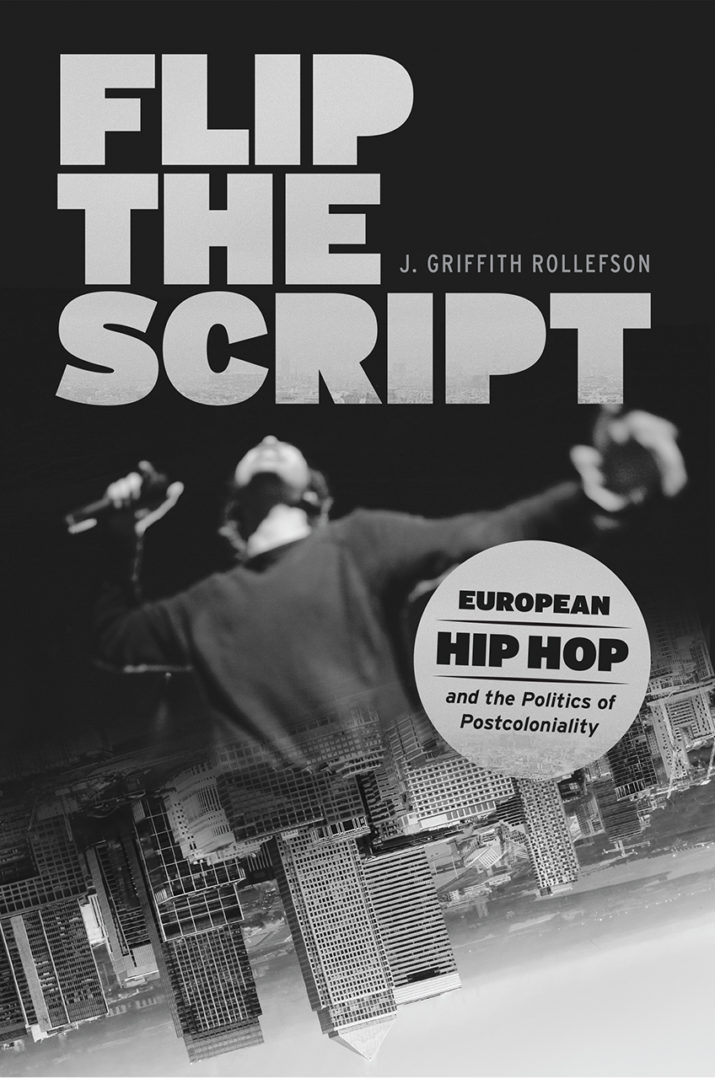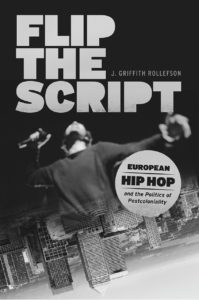
Flip The Script: European Hip Hop and the Politics of Postcoloniality by J. Griffith Rollefson
 This is part of our special feature, Beyond Eurafrica: Encounters in a Globalized World.
This is part of our special feature, Beyond Eurafrica: Encounters in a Globalized World.
Born in the United States at the end of the 1970s, hip hop has become in the last few decades a global music genre. While numerous studies have been published on various national and local hiphop scenes, J. Griffith Rollefson offers a new perspective in Flip the Script by comparing the impact of hip hop in several European cities. While hip hop has often been regarded as a vehicle for protest for African-American populations in the U.S., this book shows how it has become a powerful tool in the political debates that are shaking up several European countries. Flip the Script brings together two main issues. On one hand, it aims to re-examine the discourses dealing with American influence in a globalized world. While Americanization has often been seen as a homogenization process, Griffith Rollefson wants to show its complexity, placing it in the context of long-term exchanges that have been going on between different countries on a global scale. In particular, he shows how, far from copying its American version, hip hop in Europe is a medium through which artists develop a voice in their own national and local contexts. Therefore, Flip the Script also observes how this music genre has become a tool to address crucial aspects of European identity. While Europe has been recently shaken by crises that question its unity, Griffith Rollefson argues that hip hop artists are the vanguards of a new generation that reframes what it means to be European in a global world. This music genre sheds light on postcolonial issues that, despite having been crucial in European politics, have often been put aside in most debates. As immigrants from former colonized countries settle in the heart of the ex-colonial capitals, hip hop helps them to “flip the script” on the dominant discourse on Europe, forcing their nation to see them as an inherent part of its identity.
To analyze this issue, the book compares the lyrical, musical, and performative constructions of artists coming from three cities: Paris, Berlin, and London. This analysis is based on interviews and observations that the author carried out between 2006 and 2008, and an analysis of music material he listened in the years since. In the body of the book, Griffith Rollefson develops his argument in several steps, switching from one scene to another. Chapters 1 and 2 introduce some of the postcolonial politics at play in European hip hop, focusing on the scene in Paris. Carrying out fieldwork at the time of a presidential election, when Nicolas Sarkozy became the new president of France, Griffith Rollefson analyzes the ambiguous relations between political organizations and French rappers. He elaborates on the interesting case of SOS Racism, an association that, despite being linked with the French Socialist party, stopped inviting rappers to their meetings. Indeed, in a country where it is often asserted that there are no minorities, the mere presence of rappers raises questions. These artists embody the idea that there might be self-defined “minorities” in France, highlighting that the country needs to come to terms with its own diversity.
Despite the reluctance of mainstream political organizations to hear rappers’ voices, Griffith Rollefson argues that they represent a new model of society that highlights the multicultural dimension of French society. He develops this perspective in Chapter 2 with an in-depth analysis of “En Noir et Blanc,” a song and music video released by French rapper Sefyu. Studying simultaneously the lyrical, musical, and visual aspects of this work, this chapter shows how “En Noir et Blanc” overcomes the binary which has long structured discourses on minorities, making us think instead of the world as “métissé” (multi-ethnic). Analyzing the song through the lens of postcolonial theory, Griffith Rollefson shows that, while deeply embedded in the French context, Sefyu’s performance echoes a strategy that has been crucial in the transnational history of black music. Based on a loop of a 1962 Nina Simone’s song, “Hey Buddy Bolden,” Sefyu’s song reminds us that, even in the U.S., the rise of black music was the product of postcolonial contradictions. Recognized as one of the fathers of jazz, Buddy Bolden came from New Orleans, a city that was a nexus for Black Atlantic traffic. It is this mix between African, European, and American influences that gave birth to a specific postcolonial experience of African Americans in the U.S.: that of “double consciousness.” Once limited to the U.S., this experience gained a wider audience with the diffusion of American goods in a process that Griffith Rollefson chooses to call, to reassert its hybrid nature, “(African) Americanization.” And, as Sefyu’s work shows, this post-colonial experience of African Americans in the U.S. is now a form of expression that has become global.
To analyze in greater detail the nature of this (African) Americanization process, Chapters 3 and 4 switch the analysis to Germany, focusing on the music label Aggro Berlin. While Americanization has often been analyzed through the language of commercialization and cultural imperialism, Chapter 3 shows how Aggro Berlin’s artists use hip hop to transgress the national politically-correct culture, shedding light on racial issues that most Germans would rather have buried. From the case of Sido, who performs the working-class realities of the German housing projects, to that of B-Tight, who uses hip hop as a way to express his experience as an Afro-German, Aggro artists introduce Germany to its Others within, creating a space for their inclusion in the nation.
However, while offering new political tools for a racialized European underclass, the diffusion of (African) American forms of expression is strongly connected to the strategies carried out by mainstream cultural industries. In this context, we can ask ourselves whether, despite appearing as a political force, European hip hop is not just a new way of selling the difference, serving multinational corporations. This is a contradiction that Chapter 4 aims to explore. Focusing on the commodification of the Aggro Berlin artists, this part of the book explores an opposition between the commercial and the authentic that has long structured discourses on hip hop and black music. Taking examples from the history of African-American music, Griffith Rollefson explains that, while being perceived as a site of expression for racial authenticity, this “blackness” has always been mediated through cultural industries. This double nature is also crucial when the (African) American music model is appropriated globally, as the case of Aggro Berlin artists illustrates. Thanks to interviews carried out in Berlin, this chapter shows how the Aggro artists cultivate a racialized authenticity that explicitly goes beyond the German social norms, as a way to have visibility in the mainstream music market. But, while turning the mixtapes into a “hot commodity,” these performances also reveal the underlying racial stereotypes of the German nation, giving a voice to citizens that have long been marginalized.
Therefore, far from being an issue, this tension between the authentic and the commercial is, according to Griffith Rollefson, what makes European hip hop politically relevant. To illustrate that, Chapters 5 and 6 explore several cases of artists who combine these two elements in their performances. Chapter 5 moves the study to London, analyzing the lyrical, musical, and visual constructions of M.I.A.’s first album, Arular. After the release of this album, several media used the dismissive term of “terrorist chic” to describe M.I.A.’s performances, underlining that her discourse was not as oppositional as it claimed to be, given that it was diffused through the commercial networks of the music industries. On the contrary, Griffith Rollefson argues that the political discourse of M.I.A. takes its power from the fact that she can reach mainstream channels. In this album, M.I.A. narrates her life, from Sri Lanka to London, asserting a postcolonial identity that transcends the binaries often used in Western ways of thinking. Throughout the album, she uses lyrics that intentionally blur the lines between the third and first worlds, the representation of gendered black subjects as victims or problems, or the perception of fighters in postcolonial wars as terrorists or freedom defenders. This search for hybridity is also encountered in the music, which mixes the usual catalog of Black Atlantic music (Hip Hop, Kingston Dancehall) with other influences (Trinidad Calypso, Brazilian Samba, South Asian classic music). However, these postcolonial performances would not have been significant if it had not reached mainstream networks: it is thanks to her access to the establishment that M.I.A. can hijack their structures of oppression and contribute to reconfiguring them.
Similar strategies are found in the Parisian scene, which is the topic of Flip the Script’s sixth chapter. Focusing on a Parisian duo called Blackara, Griffith Rollefson studies how African-American struggles and cultures are used by the rappers as a tool to address blackness in France’s color-blind context. Thanks to an interview with the members of the group, this chapter shows how Blackara treat the racialized discourses within which they appear as the “cauchemar” (nightmare) of French society. These performances are aimed not only at the Right-wing parties, with their dreams of an ethnically-pure nation, but also at the left-wing defenders, who are often stuck in the dream of a race-free society. In contrast, these self-defined minority rappers choose another path: maintaining their racial identity until the ideal dream of human brotherhood becomes a practical possibility. Here as well, the Blackara’s performances appear as a way to “flip the script” of the French national narrative: instead of representing their integration into a race-free national body, these rappers use hip hop to force their nation to redefine the terms of national belonging.
Therefore, hip hop performances not only reveal the contradictions of the European postcolonial conditions, but also lay the foundations for a redefinition of the postcolonial subjects’ identity in the European contexts. These issues are analyzed in the last two chapters with an in-depth analysis of U.K. hip hop, where Griffith Rollefson delivers the most in-depth part of his work.
Chapter 7 focuses on the particular conditions in which hip hop, and more generally the codes of black music, are used in the British context. This leads Griffith Rollefson to provide a nuanced analysis of the particular structure of London hip hop, and the issues that influence it. Griffith Rollefson observes that, while there is a core hip hop scene in the city, these artists are just one specific group in a larger hip hop influenced breakbeat scene characterized by a diversity of styles. This situation can be explained, on the one hand, by the influence of the U.S. music industry in the U.K.: contrary to French or German rappers, British artists are in direct competition with American artists, as they cannot take advantage of a linguistic niche. Moreover, they have to manage their careers with a lack of authenticity and fewer resources, which leads to the exploration of different options in order to distinguish themselves from their American counterparts. On the other hand, the structure of the London scene can be interpreted as a result of an ambiguous relationship the U.K. has with black music: even though the existence of a British black music is not fully admitted by official institutions, such as the Brit awards, it has an attractive power that has led the hip hop scenes to become increasingly white in the last few years. This has led to the rise of new music styles, such as grime, which can be regarded as an answer from black minorities to the whitening of hip hop. It is in this context that we can understand the way some British artists use the codes of hip hop. The final section of Chapter 7 analyzes this issue with the example of New Flesh, a group with whom Griffith Rollefson had continuous exchanges from 2005 to 2015. Analyzing the cover and lead single from album Universally Dirty, released in 2006, the analysis shows how New Flesh uses black music’s immanent hybridity and double meaning in order to address and challenge the image of blackness not only in the U.K., but also in the world.
Chapter 8 goes further into this study by focusing on the concept album Jerusalaam Come, released by Juice Aleem, a member of the New Flew crew. In many ways this album follows and extends the analysis of the previous chapters. Indeed, Jerusalaam Come is criticizing not only the way Europe treats its “others” but also how it gives the tools for new definitions of the postcolonial self. Throughout this album, Aleem claims roots in his hometown of Birmingham, but he also combines it with references to other spaces (from Africa to Outer space) and times (from Antiquity to futuristic times). Through this Afrofuturist aesthetic, he blurs the lines between the past and the future, as well as the here and abroad, in order to deconstruct the stable geography and history of Western colonial history and build a definition of identity set free from this framework. Aside from the analysis of the album, an interesting aspect of this chapter is the way Griffith Rollefson refers to Aleem’s album: he does not just use Jerusalaam Come as a source material, but also as scholarship that contributes to academic analysis. It is with this perspective that he develops the concept of “defness,” drawing from its use in the hip hop world. In the same vein as Derrida’s idea of “différance,” the word “defness” is used to express the double meaning that hip hop performances accord to the proximity of the listener with this form of expression: while most people will see hip-hop performances as insignificant (because they remain “deaf” to this form of expression), it can appear to others as a “def” musical moment provided by a “def” speaker, that creates a space where they can build their identity apart from the dominant system of oppression.
Following this analysis, Griffith Rollefson reasserts in his conclusion that hip hop is a well-suited tool to combat the postcolonial dynamics of European countries. Having risen in the U.S. as a product of the postcolonial conditions that define the experience of African Americans, hip hop, in Europe, offers a? template for a new generation of Europeans to overcome the binaries that have long been structuring Western thought, and the inequalities they convey. Following these assertions, Griffith Rollefson concludes that there is a need for American scholars to expand their research on hip hop beyond the U.S., embracing the potential of a global Hip Hop Studies program. To illustrate this potential, he ends his book with an exploratory investigation on hip hop in Ireland, where he recently settled due to a lectureship position.
Ultimately, Flip the Script is a dense and ambitious book that will be valuable to a vast array of scholars. It will be particularly useful for those interested in European Studies, as it casts light on the postcolonial and racial dimensions that are often omitted from the analysis of European identities. It will also interest scholars studying globalization and postcolonialism, given its fresh perspective on the circulation of cultural practices, aesthetics, and political models, and the way these elements can contribute to specific local issues. Finally, Flip the Script will push the boundaries of the hip-hop scholarship that has emerged in the last few decades in Anglophone research. In addition to the comparative perspective, that has not yet been extensively explored in Hip-Hop Studies, hip-hop readers will especially appreciate Griffith Rollefson’s effort to go beyond textual analysis of the hip hop works to take account of their musical, visual, and performative dimensions. They will also be interested in the way Flip the Script puts hip-hop works on the same level as academic work, asserting the ability of this music to dialog and renew theory.
After reading this book, I would definitely encourage Griffith Rollefson to continue pursuing this stimulating work, but also to develop it in new directions. While Flip the Script offers extensive exploration of the works of specific artists located in Paris, London and Berlin, it would be particularly interesting to compare them with other discourses found in these same national and local scenes. As Flip the Script shows in the London case, hip-hop scenes are often complex and, while the analysis highlights the dialogs and confrontations between hip-hop discourse and dominant national narratives, it would be valuable to hear more about the diversity of voices that hip-hop worlds shelter. It is maybe through future collective work that Griffith Rollefson can reach this next level of analysis. In this perspective, Flip the Script will certainly lay the foundations for collaborative studies that can address the ways in which hip hop renews the identity politics of various countries, not only in Europe, but throughout the world.
Reviewed by Séverin Guillard, University Paris Est Créteil
Flip the Script: European Hip Hop and the Politics of Postcoloniality
By J. Griffith Rollefson
Publisher: University of Chicago Press
Hardcover / 295 pages / 2017
ISBN: 9780226496184
Published on March 1, 2018.




